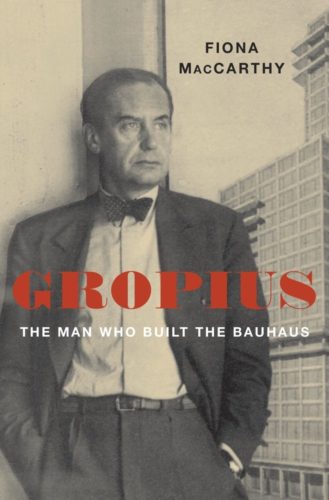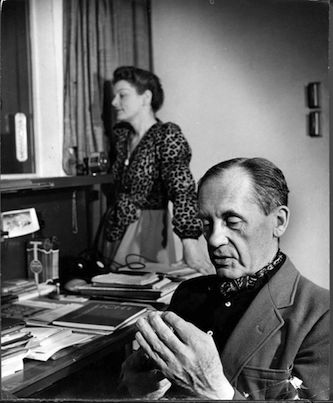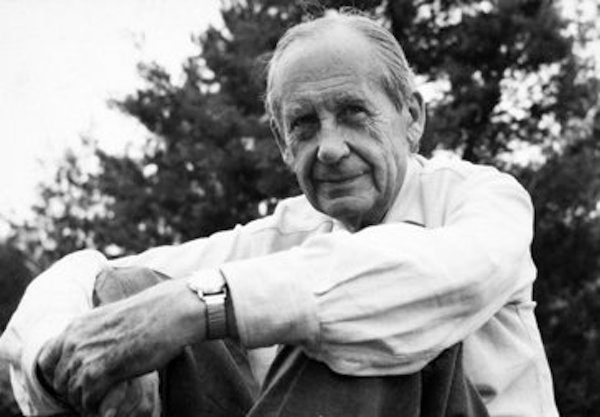Book Review: Walter Gropius — The Very Human Face of the Visionary Founder of the Bauhaus
By Mark Favermann
Award-winning author and critic Fiona MacCarthy is out to change wrong-headed perceptions of Walter Gropius in her biography. And she succeeds.
Gropius: The Man Who Built the Bauhaus by Fiona MacCarthy. Belknap Press of Harvard University Press, 545 pages, 50 photographs, $35.

His first (and angry) wife Alma Mahler, also Gustav’s first wife, described Walter Gropius bitterly and unflatteringly in her memoir on their combative marriage. Evelyn Waugh satires him in his novel Decline and Fall as the stiff and doctrinaire Otto Silenus. In his book Bauhaus to Our House, author Tom Wolfe uses him as a human swizzle stick in a sour cocktail raised to modernist architecture as little more than soulless functionalism. Frank Lloyd Wright admirers championed the latter’s “nature” inspired approach to design over Gropius’ purely rational and functional use of glass and steel. For them, Wright was warmly organic; Gropius was dismissed as all angles, coolly geometric. Over the years, he was often described by architectural critics and historians as humorless. However, in truth, though certainly ‘Germanic courtly’ in demeanor, Gropius could be quite charismatic and socially adroit.
Thankfully, award-winning author and critic Fiona MacCarthy is out to change wrong-headed perceptions in her biography. And she succeeds in challenging too long held notions that Gropius, the founder of Bauhaus, one of the fathers of modern architecture, was austere, cold, and withdrawn. Rather than giving us a portrait of a mechanical architectural rationalist, she underscores Gropius’ humanity, and how that inspired his visionary philosophy as well as the consummate aesthetic courage he showed in through an extremely volatile, even dangerous, political age.
Serving as an apprentice in the progressive architecture studio of Peter Behrens (1907-08), Gropius was exposed to modern design techniques, new building materials, and an enlightened way of understanding the built environment. This more humanistic design experience stayed with him throughout his life and career. His charm and thoughtfulness were invaluable assets in making him a superstar catalyst for great and emerging artists, designers, and architects. He managed to balance clashing egos, often through exercises of imagination as well as opportunities for collaboration.
Through his charm and intellect, Gropius was able to attract to the Bauhaus a faculty made up of celebrated artists and craftspeople that included Josef Albers, Wassily Kandinsky, Paul Klee, Laszlo Moholy-Nagy, Herbert Bayer, Anni Albers, Marianne Brandt, and Alexander Schawinsky. According to MacCarthy, Gropius encouraged innovation at the Bauhaus by setting up an environment of “creative dissidence,” the generation of debate that was specifically directed toward inspiring originality and technical innovation. This personal approach resulted in his greatly admired design philosophy as well as formidable educational legacy.
His scores of prominent students include starchitects Marcel Breuer, I.M. Pei, Paul Rudolph, Philip Johnson, Edward Durell Stone, Fumihiko Maki, Edward Larrabee Barnes, Eliot Noyes, and Yoshio Taniguchi. Gropius was a passionate advocate of a healthy exchange of ideas; colleagues and students thrived in that atmosphere of fierce discussion.

Portrait of Walter and Ise Gropius. Photo: courtesy of Historic New England.
Born in Berlin into an upper class family set at the junction of commerce and Kultur, Gropius (1883-1969) was the third child of Walter Adolph Gropius (also an architect) and Manon Auguste Pauline Scharnweber. Though he never knew him, Walter’s uncle was Martin Gropius (1824-1880), the architect of Berlin’s Museum of Decorative arts (Kunstgewerbemuseum). In 1915, Gropius married Alma Mahler, widow of the composer Gustav Mahler. Their daughter Manon (born 1916) died of polio at age 18 in 1935. Gropius and Mahler divorced less than amicably in 1920.
An officer serving in the hussars during his youth, Gropius was handsome, suave, and charismatic. During World War I, he served as a cavalry officer on the Western Front, was wounded, and received the Iron Cross for bravery. During the War, Gropius was buried alive for three days. This hellish experience no doubt informed his visionary utopian philosophy. In 1923, Gropius married Ise Frank; they remained together until his death in 1969. The couple adopted and raised a daughter, Beate Gropius, known as Ati.
Between 1910 and 1930, Gropius was strategically placed, right at the fulcrum of European modernism, which soon became known to the world as the International Style, an expression of the artistic avant-garde. During the rise of the Nazis, he was exiled to the anti-modernist United Kingdom, where he and his family stayed for several years until he was hired by Harvard University’s architectural department to lead it. There he stayed the rest of his life.
Along with Gropius’ status as one of modern architecture’s founding members, in Massachusetts his magnetic personality drew a continuous array of visitors — both friends and strangers — who were anxious to be in the shadow of the distinguished architect and teacher. He was known for his generosity of spirit and overall bonhomie. The architectural firm he helped found, The Architects Collaborative in Cambridge, MA, reflected Gropius’ forward looking focus and collaborative approach.
Notably, his house in Lincoln, MA was financed by Mrs. Helen Osborne Storrow, a prominent widowed philanthropist and progressive thinker. Her family’s generous gifts to The Esplanade and the Commonwealth of Massachusetts helped to finance (the aptly named) Storrow Drive. While at Harvard, absorbing the democratizing influence of American universities, Gropius became an advocate of public art and its valuable role in architecture.

Walter Gropius in later life. Photo: courtesy of Historic New England
Gropius’ impact can be measured not only by his several iconic buildings — including the Fagus factory, Bauhaus Dessau, New York’s Pan Am Building and Harvard’s Graduate Student Center — but his enormous influence on students and colleagues at both the Bauhaus and Harvard’s Graduate School of Design. He is also notable for his encouragement of women’s personal as well as artistic endeavors, his much imitated teamwork approach to art and architectural education (which has permeated design schools world-wide), and his egalitarian belief that high design was for everyone, not just the wealthy.
Gropius has long been described, incorrectly, as humorless and cold. Though she does ample justice to the man’s importance as an unquestioned eminence in the history of architecture, design, and art, MacCarthy makes a needed case for Gropius as an affable family man and collegial professional colleague who exuded a very warm, very human presence.
An urban designer and public artist, Mark Favermann has been deeply involved in branding, enhancing, and making more accessible parts of cities, sports venues, and key institutions. Also an award-winning public artist, he creates functional public art as civic design. Mark created the Looks of the 1996 Centennial Olympic Games in Atlanta, the 1999 Ryder Cup Matches in Brookline, MA, and the 2000 NCAA Final Four in Indianapolis. The designer of the renovated Coolidge Corner Theatre, he is design consultant to the Massachusetts Downtown Initiative Program. Since 2002, Mark has been a design consultant to the Red Sox. Mark is Associate Editor of Arts Fuse.
Tagged: Fiona MacCarthy, Gropius: The Man Who Built the Bauhaus, Ise Gropius, Mark Favermann

